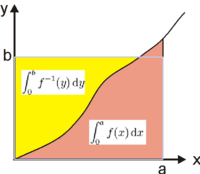Young's inequality for products

Young's inequality for products is a math rule that tells us how big the product of two numbers can be. Imagine you have two numbers, let's call them a and b. Young's inequality says that the product of a and b can't be bigger than the sum of two other numbers, let's call them p and q.
Now, how do we find these numbers p and q? It's actually quite simple. We just need to choose two other numbers, let's call them r and s, that satisfy two conditions:
1. They add up to one: r + s = 1.
2. They satisfy a certain relationship with a and b: r/a + s/b = 1.
Okay, so what does that mean in simpler terms? It means that if we take one part of r for every part of a, and one part of s for every part of b, then when we add them together, we get a total of one part.
For example, let's say a = 2 and b = 3. We need to find numbers r and s that add up to one and satisfy the relationship r/a + s/b = 1. Let's try r = 2/5 and s = 3/5. Then, r/a + s/b = (2/5)/2 + (3/5)/3 = 1. So, we've found our numbers!
Now, we can plug these values into Young's inequality: ab ≤ pa^r + qb^s. Since a = 2 and b = 3, we have ab = 6. Plugging in r = 2/5 and s = 3/5, we get pa^r + qb^s = p(2^(2/5)) + q(3^(3/5)). And since r + s = 1, we know that p + q = 1. So, we can rewrite the inequality as:
6 ≤ p(2^(2/5)) + q(3^(3/5))
And that's it! Young's inequality tells us that the product of two numbers can't be bigger than the sum of two other numbers, which we can find by choosing two other numbers that satisfy the conditions r + s = 1 and r/a + s/b = 1.
Now, how do we find these numbers p and q? It's actually quite simple. We just need to choose two other numbers, let's call them r and s, that satisfy two conditions:
1. They add up to one: r + s = 1.
2. They satisfy a certain relationship with a and b: r/a + s/b = 1.
Okay, so what does that mean in simpler terms? It means that if we take one part of r for every part of a, and one part of s for every part of b, then when we add them together, we get a total of one part.
For example, let's say a = 2 and b = 3. We need to find numbers r and s that add up to one and satisfy the relationship r/a + s/b = 1. Let's try r = 2/5 and s = 3/5. Then, r/a + s/b = (2/5)/2 + (3/5)/3 = 1. So, we've found our numbers!
Now, we can plug these values into Young's inequality: ab ≤ pa^r + qb^s. Since a = 2 and b = 3, we have ab = 6. Plugging in r = 2/5 and s = 3/5, we get pa^r + qb^s = p(2^(2/5)) + q(3^(3/5)). And since r + s = 1, we know that p + q = 1. So, we can rewrite the inequality as:
6 ≤ p(2^(2/5)) + q(3^(3/5))
And that's it! Young's inequality tells us that the product of two numbers can't be bigger than the sum of two other numbers, which we can find by choosing two other numbers that satisfy the conditions r + s = 1 and r/a + s/b = 1.
Related topics others have asked about:
